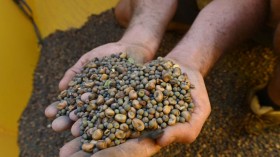The Australian Redclaw Crayfish, an invasive species that has been discovered in some parts of the state, is being warned about by officials because it may carry the crayfish plague and other diseases.
The first known location in Texas where the invasive Australian Redclaw Crayfish (Cherax quadricarinatus) was discovered was recently visited by researchers from the University of Texas Rio Grande Valley.
Three samples were gathered between January and February at an apartment complex pond in the Brownsville region that is connected to a close-by resaca.
Alien Crayfish Sightings
This species has likely been present in this area for some time, as evidenced by the identification on iNaturalist of a female species seen there in 2013 along with several young. This is only the second time that this species has been found in the wild in the United States; the first was in California.
Dr. Archis Grubh, an aquatic biologist with the Texas Parks and Wildlife Department (TPWD), searched several locations in the region during the month of July and discovered three more Australian Redclaw Crayfish between both the apartment complex pond and a nearby resaca, which is two miles away.
Grubh stated that They are unsure of the origin or extent of the spread of these invasive crayfish, but they do know that they can harm regional biodiversity and species. By educating people about such an invasive species and receiving sighting reports, TPWD can better understand its distribution and perhaps take action to stop it.
It has been easy to collect both female and male Australian Redclaw Crayfish, raising questions about these bodies of water's potential for reproduction.
Australian Redclaw Crayfish
The females of the species can produce 1,000 eggs per clutch up to five times a year, which indicates how prolifically they can reproduce. Australian Redclaw Crayfish have a quick growth rate and can grow up to two pounds in weight in less than a year.
These large crayfish have the potential to significantly alter vegetation and habitat, compete with native crayfish, and directly prey on native fish populations.
Additionally, Crayfish Plague and other parasites or diseases that might affect native crayfish can be carried by Australian Redclaw Crayfish.
The four distinct ridges on the top of the head and the large size of the Australian Redclaw Crayfish make them easy to identify. They also have large left claws with a distinct red patch on the outside.
Slow-moving streams and still bodies of water with high turbidity, like oxbows and resacas, are their preferred habitat. They can move between bodies of water and over moist terrestrial vegetation.
With seasonal rainfall which can spread the crayfish across waterbodies, there is an increase in the introduction to new areas.
Read also: Scottish Chef Makes Delicacies Out of Squirrels to Combat Invasive Species: Discussing Invasivorism
Invasive and Prohibited in Texas
The Australian Redclaw Crayfish, along with the rest of the Parastacidae family of crayfish, are illegal exotic species in Texas and cannot be bought, sold, or kept in aquariums. Releasing these crayfish species into a public body of water is also prohibited.
Monica McGarrity, TPWD Senior Scientist for Aquatic Invasive Species, said that unfortunately, one of the primary methods by which invasive species, like these crayfish, are introduced is through the release of aquarium life. When aquarium owners release their pets, they frequently believe they are doing what is best for the animals.
However, if the pets survive, they may become invasive and damage the ecosystem and native aquatic species. To stop the spread of the next invasive species, aquarium owners should look into alternatives to aquarium dumping, TPWD News reports.
Australian Redclaw Crayfish sightings must be reported to TPWD by sending an email of the pictures and location data to the relevant authorities.
Related article: Invasive Species: Growing Population of Crayfish and Carps in Lakes Cause Rapid Ecosystem Collapse
© 2024 NatureWorldNews.com All rights reserved. Do not reproduce without permission.





